Entry Database : PDB / ID : 6wy1Title Crystal structure of an engineered thermostable dengue virus 2 envelope protein dimer Dengue 2 soluble recombinant envelope Keywords / / / / / Function / homology Function Domain/homology Component
/ / / / / / / / / / / / / / / / / / / / / / / / / / / / / / / / / / / / / / / / / / / / / / / / / / / / / / / / / / / / / / / / / / / / / / / / / / / / / / / / / / / / / / / / / / / / / / / / / / / / / / / / / / / / / / / Biological species Method / / / Resolution : 3.42 Å Authors Kudlacek, S.T. / Lakshmanane, P. / Kuhlman, B. Funding support Organization Grant number Country Department of Defense (DOD, United States) W81XWH1820035 National Institutes of Health/National Institute Of Allergy and Infectious Diseases (NIH/NIAID) 5 F31 AI145408-02
Journal : Sci Adv / Year : 2021Title : Designed, highly expressing, thermostable dengue virus 2 envelope protein dimers elicit quaternary epitope antibodies.Authors: Kudlacek, S.T. / Metz, S. / Thiono, D. / Payne, A.M. / Phan, T.T.N. / Tian, S. / Forsberg, L.J. / Maguire, J. / Seim, I. / Zhang, S. / Tripathy, A. / Harrison, J. / Nicely, N.I. / Soman, S. ... Authors : Kudlacek, S.T. / Metz, S. / Thiono, D. / Payne, A.M. / Phan, T.T.N. / Tian, S. / Forsberg, L.J. / Maguire, J. / Seim, I. / Zhang, S. / Tripathy, A. / Harrison, J. / Nicely, N.I. / Soman, S. / McCracken, M.K. / Gromowski, G.D. / Jarman, R.G. / Premkumar, L. / de Silva, A.M. / Kuhlman, B. History Deposition May 12, 2020 Deposition site / Processing site Revision 1.0 Nov 10, 2021 Provider / Type Revision 1.1 Oct 18, 2023 Group / Refinement descriptionCategory / chem_comp_bond / pdbx_initial_refinement_model
Show all Show less
 Yorodumi
Yorodumi Open data
Open data Basic information
Basic information Components
Components Keywords
Keywords VIRAL PROTEIN /
VIRAL PROTEIN /  Dengue virus /
Dengue virus /  envelope protein /
envelope protein /  thermostable /
thermostable /  computational protein design /
computational protein design /  protein engineering
protein engineering Function and homology information
Function and homology information viral capsid /
viral capsid /  double-stranded RNA binding / protein complex oligomerization / monoatomic ion channel activity ...symbiont-mediated suppression of host JAK-STAT cascade via inhibition of host TYK2 activity / host cell mitochondrion / symbiont-mediated suppression of host JAK-STAT cascade via inhibition of STAT2 activity / symbiont-mediated suppression of host cytoplasmic pattern recognition receptor signaling pathway via inhibition of MAVS activity / ribonucleoside triphosphate phosphatase activity / : /
double-stranded RNA binding / protein complex oligomerization / monoatomic ion channel activity ...symbiont-mediated suppression of host JAK-STAT cascade via inhibition of host TYK2 activity / host cell mitochondrion / symbiont-mediated suppression of host JAK-STAT cascade via inhibition of STAT2 activity / symbiont-mediated suppression of host cytoplasmic pattern recognition receptor signaling pathway via inhibition of MAVS activity / ribonucleoside triphosphate phosphatase activity / : /  viral capsid /
viral capsid /  double-stranded RNA binding / protein complex oligomerization / monoatomic ion channel activity / clathrin-dependent endocytosis of virus by host cell /
double-stranded RNA binding / protein complex oligomerization / monoatomic ion channel activity / clathrin-dependent endocytosis of virus by host cell /  mRNA (nucleoside-2'-O-)-methyltransferase activity / mRNA 5'-cap (guanine-N7-)-methyltransferase activity /
mRNA (nucleoside-2'-O-)-methyltransferase activity / mRNA 5'-cap (guanine-N7-)-methyltransferase activity /  RNA helicase activity / host cell endoplasmic reticulum membrane /
RNA helicase activity / host cell endoplasmic reticulum membrane /  protein dimerization activity / induction by virus of host autophagy / viral RNA genome replication /
protein dimerization activity / induction by virus of host autophagy / viral RNA genome replication /  RNA-dependent RNA polymerase activity / serine-type endopeptidase activity / fusion of virus membrane with host endosome membrane /
RNA-dependent RNA polymerase activity / serine-type endopeptidase activity / fusion of virus membrane with host endosome membrane /  viral envelope / symbiont-mediated suppression of host type I interferon-mediated signaling pathway / host cell nucleus / virion attachment to host cell / virion membrane / structural molecule activity /
viral envelope / symbiont-mediated suppression of host type I interferon-mediated signaling pathway / host cell nucleus / virion attachment to host cell / virion membrane / structural molecule activity /  proteolysis / extracellular region /
proteolysis / extracellular region /  ATP binding /
ATP binding /  membrane /
membrane /  metal ion binding
metal ion binding
 Dengue virus 2
Dengue virus 2 X-RAY DIFFRACTION /
X-RAY DIFFRACTION /  SYNCHROTRON /
SYNCHROTRON /  MOLECULAR REPLACEMENT / Resolution: 3.42 Å
MOLECULAR REPLACEMENT / Resolution: 3.42 Å  Authors
Authors United States, 2items
United States, 2items  Citation
Citation Journal: Sci Adv / Year: 2021
Journal: Sci Adv / Year: 2021 Structure visualization
Structure visualization Molmil
Molmil Jmol/JSmol
Jmol/JSmol Downloads & links
Downloads & links Download
Download 6wy1.cif.gz
6wy1.cif.gz PDBx/mmCIF format
PDBx/mmCIF format pdb6wy1.ent.gz
pdb6wy1.ent.gz PDB format
PDB format 6wy1.json.gz
6wy1.json.gz PDBx/mmJSON format
PDBx/mmJSON format Other downloads
Other downloads https://data.pdbj.org/pub/pdb/validation_reports/wy/6wy1
https://data.pdbj.org/pub/pdb/validation_reports/wy/6wy1 ftp://data.pdbj.org/pub/pdb/validation_reports/wy/6wy1
ftp://data.pdbj.org/pub/pdb/validation_reports/wy/6wy1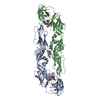
 Links
Links Assembly
Assembly

 Components
Components
 Dengue virus 2 / Plasmid: P-alphaH / Cell line (production host): EXPI293F / Production host:
Dengue virus 2 / Plasmid: P-alphaH / Cell line (production host): EXPI293F / Production host: 
 Homo sapiens (human) / References: UniProt: D0EPS0
Homo sapiens (human) / References: UniProt: D0EPS0 N-Acetylglucosamine
N-Acetylglucosamine X-RAY DIFFRACTION / Number of used crystals: 1
X-RAY DIFFRACTION / Number of used crystals: 1  Sample preparation
Sample preparation
 SYNCHROTRON / Site:
SYNCHROTRON / Site:  APS
APS  / Beamline: 22-ID / Wavelength: 1 Å
/ Beamline: 22-ID / Wavelength: 1 Å : 1 Å / Relative weight: 1
: 1 Å / Relative weight: 1  Processing
Processing :
:  MOLECULAR REPLACEMENT
MOLECULAR REPLACEMENT Movie
Movie Controller
Controller


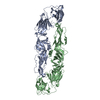
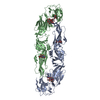
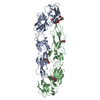
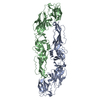
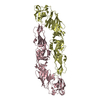
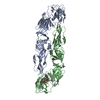
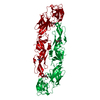

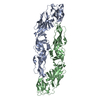
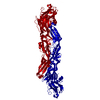


 PDBj
PDBj



